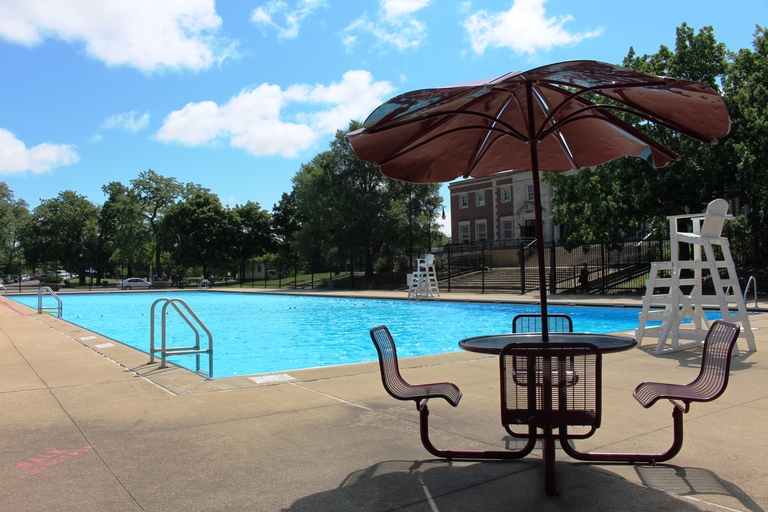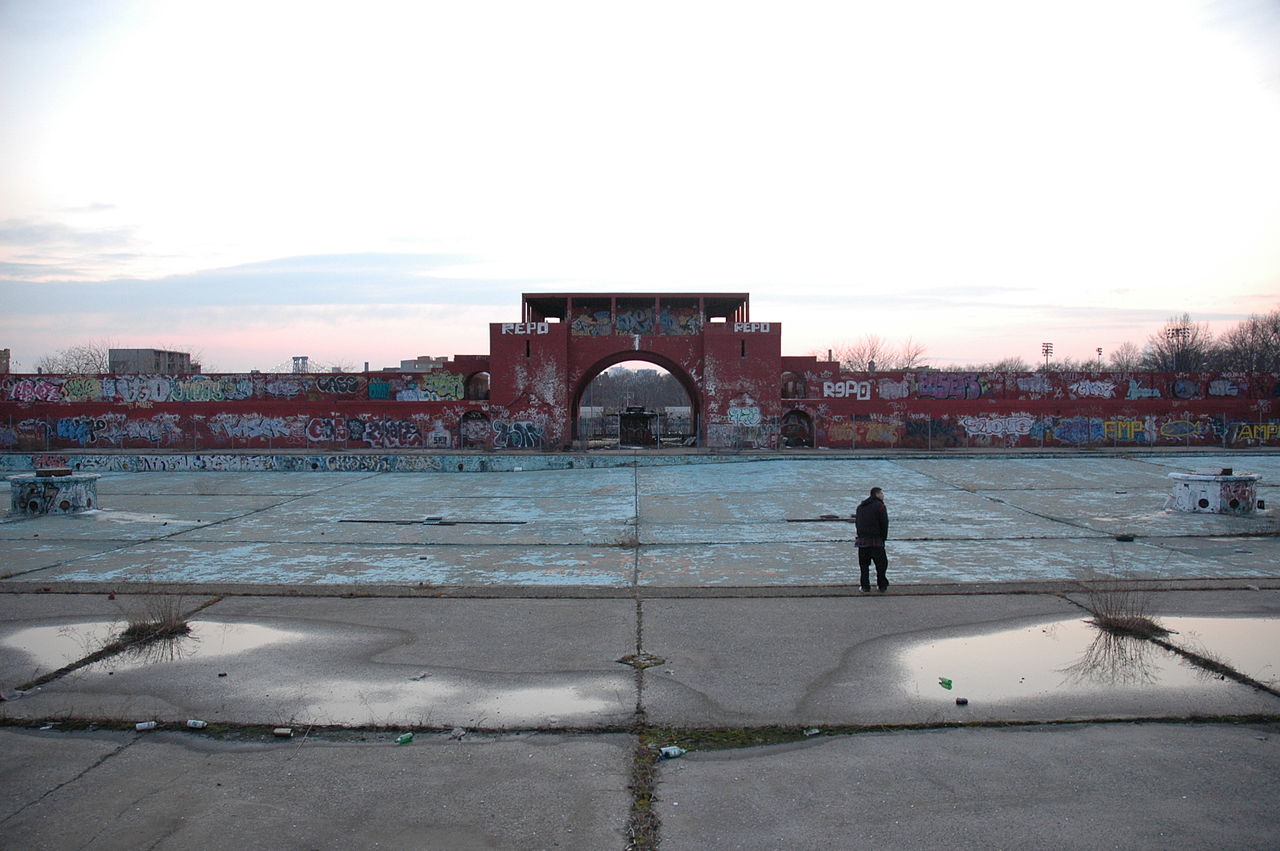On a sweltering Friday afternoon in Chicago earlier this month, I was in desperate search of relief from the heat. The single air-conditioning unit in my third-floor apartment bedroom was not cutting it: I needed to submerge my body in cold water, fast.
I could have hauled it over to Lake Michigan, but biking for forty minutes in more than 100 degrees was inadvisable. Luckily, just a few blocks from my apartment lay an anodyne oasis: my local public pool.
Within minutes, I walked through the open gate, threw my towel over an unclaimed lounge chair, and hopped into the deep end. My body temperature felt instantly lowered, and I felt grateful for the ability to take advantage of such a vital public good, for free, at just the moment I needed it most.
Well-run public swimming pools are municipal treasures. Beyond being spots to take a dip, they’re third places that are imbued with a social democratic promise. Since their emergence in the late nineteenth century, public pools have been sites of both leisure and struggle, where the fight for a more inclusive vision of social and civic life has played out.
Today, as the federal government mounts an all-out assault on the public sphere, and as the climate crisis creates an urgent need for more spaces to cool off, we can make a clear demand: more public pools.
The first public pool in the United States wasn’t actually built for swimming. Boston’s Cabot Street Bath, opened in 1868, was a place for local immigrant, working-class, and poor residents to bathe alongside each other at a time when indoor plumbing remained largely confined to the homes of the wealthy. Lower-income bathers would come to the facility to wash themselves in strictly gender-segregated pools. As author Jeff Wiltse writes of Cabot Street in Contested Waters: A Social History of Swimming Pools in America, “Bathers plunged their dirty bodies into the water and rubbed their skin clean.”
Such “plunge baths” grew in popularity over the following two decades and were intended to halt the spread of diseases spreading among the urban poor such as cholera and tuberculosis. But modern germ theory wasn’t widely accepted at the time, and the pool water was rarely replenished, so these baths regularly turned into cesspools and quickly became outdated.
Nearly two decades later, in 1887, a public swimming pool opened in nearby Brookline, Massachusetts, the first of its kind meant for visitors to fraternize and beat the summer heat. By 1895, the first public swimming pool designed to be used for recreation and sports was opened in Douglass Park on Chicago’s West Side. These pools offered more sanitary conditions and regulation to protect public health.
By the 1920s and ’30s, the “Swimming Pool Age” had swept the country. Thousands of new public pools were installed state to state, from Davenport, Iowa’s Municipal Natatorium, the construction of which was spearheaded by a socialist mayor and city council; to Hamilton Fish Pool in New York City’s Lower East Side, which opened alongside ten other city public pools in the summer of 1936, which saw celebratory parades and water carnivals across the five boroughs.
Built during the New Deal era under President Franklin D. Roosevelt’s Works Progress Administration (WPA), this new public pool system offered an escape from the heat for working-class New Yorkers and serviced nearly two million city residents during its first year in operation. It brought with it innovations such as treated sanitized water that was changed three times daily, and architectural grandeur including Romanesque revival and Art Deco–styled designs.
McCarren Park Pool in Brooklyn’s Greenpoint neighborhood today stands as one of the remaining monuments of this era, open every summer for visitors who pass under a vaulted entryway that the New York City Parks Department describes as “reminiscent of the Karl Marx Hof housing complex in Vienna.”

Workers employed by the WPA and Civil Works Administration (CWA) together built and repaired more than one thousand public pools in cities and towns throughout the United States over the course of the dual Depression-era projects. These landmarks of FDR’s progressive vision for government provided sites of relaxation and community for an economically struggling stratum.
As the often vilified but inarguably productive New York City Parks Commissioner Robert Moses stated in 1934, when announcing the city’s ambitious public pool construction plan that came to fruition two years later:
It is an undeniable fact that adequate opportunities for summer bathing constitute a vital recreational need of the city. It is no exaggeration to say that the health, happiness, efficiency, and orderliness of a large number of the city’s residents, especially in the summer months, are tremendously affected by the presence or absence of adequate bathing facilities.
While public pools largely moved away from gender segregation starting in the 1920s, racial discrimination played an increasingly pernicious role in the decades following the first Great Migration of African Americans to the North. In the Jim Crow South, racial segregation of pools remained law, and in Northern states, as Wiltse writes in Contested Waters, “white swimmers imposed and enforced racial segregation through violence,” both unofficially in the form of verbal harassment as well as in official policies such as only allowing swimmers of color in the pool during extremely restricted hours. This practice helped give rise to the 1944 Lopez v. Seccombe Supreme Court case, which forced the integration of public pools in San Bernardino, California. Ten years later, that ruling was cited as a legal precedent for the court’s pivotal Brown v. Board of Education decision that officially ended segregation in public schools.
Still, the 1950s and ’60s saw brutal treatment of African Americans and other people of color attempting to use the public swimming facilities they were entitled to. During this period, Sadler Beale explains in the Journal of Leisure Research, “Municipal swimming pools were literally a battleground as Blacks struggled for equal access to public amenities.”
As the civil rights movement continued to strike blows at legalized white supremacy, when it came to public pools, many whites simply abandoned the amenities rather than embrace integration. This bigotry-fueled boycott, as well as “white flight” — which saw white Americans flee cities for suburban enclaves starting in the post-WWII era, reshaping the demographic landscape — led to a massive reduction in the use of these pools. In her book The Sum of Us: What Racism Costs Everyone and How We Can Prosper Together, Heather McGhee writes that following the 1950s, “Millions of white Americans who once swam in public for free began to pay rather than swim for free with Black people; desegregation in the mid-fifties coincided with a surge in backyard pools and members-only swim clubs.”

The result was extreme dilapidation of the US public pool system, which led to large-scale closures. The same period saw the rapid growth of private swim clubs with exclusive membership. The country has never fully recovered from this racist desertion of public pools for their privatized counterparts, and the results have been stark: While as of last year there were more than ten million private pools across the United States, the number of public pools stood at just 309,000.
In her book Still Drowning in Segregation: Limits of Law in Post–Civil Rights America, civil rights attorney Taunya Lovell Banks writes that “ironically, those groups for whom public swimming pools were initially created, working class and impoverished families in densely populated urban areas, are today the groups with the most limited access to swimming facilities.”
In my experience, pools are wellsprings of rejuvenation. Swimming can help extend the length of your life, and that adrenaline rush through your system when you jump into the deep end has to be good for you. Studies show that positive health effects range from avoiding the chance of heat stroke to lowering blood pressure and improving heart strength.
Summer 2025 opened with a heat dome encasing vast swaths of the United States, causing “dangerous, life-threatening” levels of heat in the triple digits — powered by fossil fuel–driven climate change. Every year is now hotter than the last, and extreme heat has become the number-one weather-related cause of death in the United States.
Access to pools can help alleviate the deleterious effects of spiking temperatures on our bodies. But as Eve Andrews reports at the Atlantic, the country’s public pool infrastructure has fallen into disrepair over the past 50 years, following a broader trend of disinvestment in public infrastructure starting in the 1970s, allowing privatization to run amok. This long decline has been fueled by fiscal austerity and neglect — but it also can be reversed.

There’s nothing stopping our politicians and policymakers from investing in building more pools and making them accessible to more people in search of a place to dive in.
Employment increases, especially for youth, as lifeguard and maintenance jobs open up to staff public pools. Kids are provided a haven to play in the water under supervision while parents can eke out some amount of relaxation. Learning to swim helps prevent drownings, and as Allie Volpe writes at Vox, pools are “places where non-swimmers learn crucial water safety skills.”
Social impacts of public pools, meanwhile, are immeasurable. One of the reasons racist reactionaries fought so intensely against the integration of public pools is because they’re zones where differences of race and class can break down. You can socialize and build connections with your neighbors in an inclusive, free community space.
Despite the long trend of disinvestment, there have been a number of recent efforts on the municipal level to expand public pool accessibility. In New Haven, Connecticut, officials announced a plan last month to turn a deteriorating power plant into the city’s first outdoor public pool, alongside a waterfront park. This summer, under new Chicago Parks District superintendent Carlos Ramirez-Rosa — a democratic socialist former city council member — the city has kept its fifty public pools open seven days a week for the first year since the COVID-19 pandemic shutdown in 2020, and nineteen pools located in areas with high heat risk will be kept open for an extended period through Labor Day. Last year, New York City officials unveiled a plan dubbed Let’s Swim NYC that aims to invest $1 billion in improving existing public pools while opening up two new ones at public schools in the city.
These measures are a start. Democratic nominee for New York City mayor Zohran Mamdani, a democratic socialist state assemblymember, has campaigned on bolstering the supply of public goods and services to improve life for working-class residents. Building many more public pools would help accomplish that goal. And it would follow in the footsteps of former New York City mayor Fiorello LaGuardia, who oversaw the establishment of the WPA swimming pools in the 1930s (and who Mamdani has called the “greatest mayor in our history”).
When it gets too hot out, it’s natural to want to wade in some crisp, refreshing waters. Pools bring us together, offering recreation and a way to break free from the stresses of modern life. The United States built an expansive network of public pools before. We can do it again.
Great Job Miles Kampf-Lassin & the Team @ Jacobin Source link for sharing this story.





